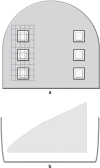Reliability and discriminatory power of methods for dental plaque quantification
- PMID: 20485931
- PMCID: PMC5349756
- DOI: 10.1590/s1678-77572010000200014
Reliability and discriminatory power of methods for dental plaque quantification
Abstract
Objective: This in situ study evaluated the discriminatory power and reliability of methods of dental plaque quantification and the relationship between visual indices (VI) and fluorescence camera (FC) to detect plaque.
Material and methods: Six volunteers used palatal appliances with six bovine enamel blocks presenting different stages of plaque accumulation. The presence of plaque with and without disclosing was assessed using VI. Images were obtained with FC and digital camera in both conditions. The area covered by plaque was assessed. Examinations were done by two independent examiners. Data were analyzed by Kruskal-Wallis and Kappa tests to compare different conditions of samples and to assess the inter-examiner reproducibility.
Results: Some methods presented adequate reproducibility. The Turesky index and the assessment of area covered by disclosed plaque in the FC images presented the highest discriminatory powers.
Conclusion: The Turesky index and images with FC with disclosing present good reliability and discriminatory power in quantifying dental plaque.
Figures
References
-
- Addy M, Renton-Harper P, Newcombe R. Plaque regrowth studies: discriminatory power of plaque index compared to plaque area. J Clin Periodontol. 1999;26:110–112. - PubMed
-
- Angmar-Mansson B, ten Bosch JJ. Quantitative light-induced fluorescence (QLF): a method for assessment of incipient caries lesions. Dentomaxillofac Radiol. 2001;30:298–307. - PubMed
-
- Block PL, Lobene RR, Derdivanis JP. A two-tone dye test for dental plaque. J Periodontol. 1972;43:423–426. - PubMed
-
- Breuer MM, Cosgrove RS. The relationship between gingivitis and plaque levels. J Periodontol. 1989;60:172–175. - PubMed
-
- Claydon N, Addy M. The use of planimetry to record and score the modified Navy index and other area-based plaque índices. A comparative toothbrush study. J Clin Periodontol. 1995;22:670–673. - PubMed
Publication types
MeSH terms
Substances
LinkOut - more resources
Full Text Sources


